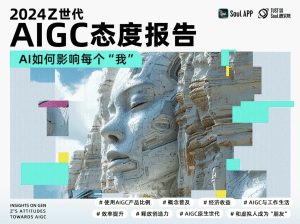
Although the introduction of ChatGPT at the end of 2022 set into motion a revolution of artificial intelligence, it’s 2024 that can truly be called the year of intelligent computing. The first two quarters of this year have witnessed the trepidations pertaining to artificial intelligence slowly but consistently waning away. So, Soul App, which is a leading social media platform in China dominated by a primarily Gen Z user base, launched a survey to understand the changing dynamics between youngsters and artificial intelligence.
For the purpose of the survey, Soul specifically focused on Artificial Intelligence Generated Content or AIGC products. To have a clarity about the precise artificial intelligence-based tools that the survey would refer to, the social platform relied on the definition of AIGC as offered by the China Academy of Information and Communications Technology.
In a recently released whitepaper, the Academy clarified that AIGC is more than just a set of artificial intelligence-powered programs. In the publication, the technology was referred to as a unique approach to content creation and even a type of content itself that involves the use of intelligent algorithms to produce content without too much or no human involvement at all.
The most popular of AIGC products was and remains ChatGPT but others like Sora and Suno aren’t too far behind. One of the reasons for the popularity of these AIGC tools is the sheer power of creativity that they bring to the table. Far from being restricted to just one type of content or a monotonous output that lacks coherence, AIGC delivers on multiple fronts and its responses have an uncanny human quality to them.
From paintings and poetry to music and videos and from general chitchat to intuitive explanations of academic concepts, AIGC tools can handle them all and more. In fact, the Soul survey found that one of the reasons for the rise of AIGC is the ability of this technology to boost productivity in multiple areas when it comes to the professional front.
According to the results of the Soul survey, almost 90% of the respondents, the majority of who were Zoomers, had used AIGC tools. However, except for about 30% of those surveyed, all others admitted to not knowing much about the academic concept and even the technical workings of AIGC. That being the case, nearly 6% asserted that they were comfortable with and even proficient at using certain industry-specific AIGC tools. About 29% of those surveyed said that they had learned about AIGC products and even tried such tools.
Of the 3400 plus people who participated in the Soul survey, nearly 20% stated that they were using AIGC tools every day, and unsurprisingly, most of these frequent AIGC users were Gen Zers. In terms of specific AIGC products, ChatGPT had the most stellar and largest fan following with well above 65% saying that they had used and continue to use the ChatGPT for personal, academic, and professional tasks.
Just So Soul, the research division of Soul, also specifically included questions in the survey that were meant to understand the current attitude towards AIGC technology. The idea was to know more about how youngsters felt not just about the development of AIGC but also about its impact on their personal and professional lives as well as the potential that the technology had to create new business opportunities.
About 60% of those surveyed said that they now feel more positive about AIGC tools. In fact, of these 60%, more than 45% expressed a liking for AIGC technology while 18% said that they appreciated what AIGC tools have to offer. Fewer than 2% of the respondents said that they disliked the technology and just 0.66% confessed to hating AIGC tools.
In response to questions meant to understand what aspects of AIGC products appeal to these young users, almost 63% cited enhancement in work efficiency as the primary reason for their use of the technology and appreciation for AIGC products. Around 54% stated that AIGC technology makes things more convenient professionally while 54% called their experience of using AIGC tools both interesting and entertaining.
Of course, it wasn’t just positivity all around. Nearly 43% of the Soul survey respondents confessed to being worried about the job loss caused by AIGC currently and the overall impact that the technology would have on employment prospects in the future. A little over 38% of the respondents were concerned about the deterioration in online content quality that AIGC may cause over time. Around 20% also expressed their fears about AIGC-related data security issues and privacy problems.
That being said, the overall user sentiment about AIGC products was found to be more on the positive side than what it was last year. For instance:
- Almost 15% of respondents said that they had already used AIGC tools to make money.
- More than 43% stated that they intend to monetize AIGC in the near future.
- About 60% said that they had already explored social networking products based on AIGC technology.
- Around 33% of those surveyed showed a willingness to befriend an AI chatbot.
- Over one-half of all respondents asserted that they believe AIGC products have the potential to tackle loneliness and lack of companionship experienced by youngsters.
If these figures from the Soul survey are any indication, then the future seems bright not just for AIGC technology but also for its users. In fact, given the proliferation of artificial intelligence across industries, those who haven’t yet warmed up to the technology face the risk of being left behind. But, Gen Z is not the cohort that shies away from transformative tech. So, chances are that the future will see more youngsters rapidly hopping onto the AIGC bandwagon and cashing in on the potential of this up-and-coming technological wave.
